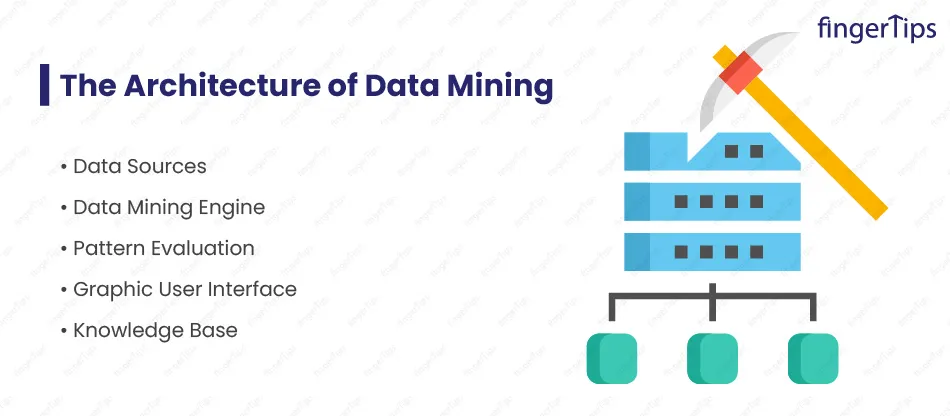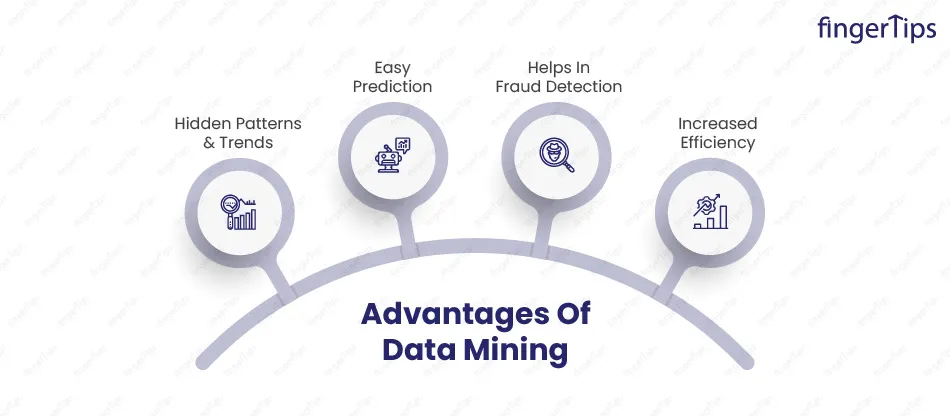In today's digital age, one of the most powerful tools for any business is data. And when information is in abundance, business requires a concept called data mining to manage that data. Data mining is also called KKD, which stands for knowledge discovery in data. KKD analyzes data sets to extract actionable insights. The whole process includes multiple techniques like data cleaning, data selection, pattern identification, and much more. This tutorial on data mining architecture includes all the topics that you need to know about data mining. It covers types of data mining architecture, the advantages of data mining, and the disadvantages of data mining. Let's start the tutorial with what is data mining.
What Is Data Mining?
Think of data as a storehouse of knowledge and data mining as the road map that reveals its buried treasures. Data mining is the process of filtering vast amounts of data to uncover insightful patterns and trends that might take time to become apparent. It resembles finding hidden connections among several pieces of knowledge.
Data mining identifies patterns, connections, and significant correlations in the data using statistical methods and computer algorithms. It helps corporations forecast consumer behavior, scientific discovery of new links in the study and even offers customized suggestions on streaming platforms.
In essence, data mining converts unusable information from raw data. It is a tool that enables decision-makers to take well-informed decisions by giving them a deeper comprehension of the available data. Data mining is the key to extracting insights from the immense sea of data surrounding us, from identifying market patterns to forecasting medical consequences.
After seeing and understanding what is data mining, let's see the architecture of the data mining system to understand how data mining works.
The Architecture of Data Mining

Data mining architecture consists of strategic processes that are involved in whole data mining. The architecture helps in guiding the professionals systematically through multiple steps. Let's see what those are:
Data Sources
For the process of data mining to get successful, organizations must have huge sets of historical data. This data is stored in a data warehouse or database. There are multiple data sources available that organizations can select from, like WWW, or the Internet, in the form of text files or spreadsheets.
Data Mining Engine
Data mining engine forms the base for data mining architecture. It has software and tools that extract insights from data that is stored in multiple data sources. Multiple techniques like classification, time-series analysis, prediction, clustering, etc, are applied to get the desired results.
Pattern Evaluation
The data mining architecture's pattern evaluation module rates the usefulness and importance of patterns that have been found. It uses metrics, statistical techniques, and user-defined criteria to assess the significance of found patterns, assisting analysts in extracting useful information from the data.
Graphic User Interface
Thanks to the Graphic User Interface (GUI) in data mining architecture, users can interact with the data mining process on an interactive platform. Providing visual tools makes the complicated processes of data analysis and pattern identification simpler by allowing users to set parameters, visualize outcomes, and make defensible conclusions.
Knowledge Base
Data mining architecture stores domain-specific knowledge, rules, and prior insights in a knowledge base; it helps to contextualize and explain results and patterns, improving the comprehension of data mining. This repository aids in decision-making and improves analysis, advancing data mining techniques.
With this, let's see what are types of data mining architecture.
Types of Data Mining Architecture

Loose Coupling Data Mining
In data mining, loose coupling refers to the design of systems with relatively independent components and algorithms, enabling simple integration, replacement, or updating without interfering with the entire procedure. It encourages flexibility and adaptation, making it possible to seamlessly incorporate new methodologies and algorithms while minimizing the effect on the entire data mining system.
Tight Coupling Architecture
In data mining, tight coupling denotes a high level of interdependence between system elements and algorithms. Changes to one area may have a significant impact on others, possibly resulting in interruptions. While it may be effective in some circumstances, it may also hinder adaptability and make it difficult to adopt new techniques or technologies without major rework.
Data Layer
The fundamental stratum where raw data is located is referred to as the data layer in data mining. It includes a variety of sources, including files, databases, and spreadsheets. To prepare data for analysis, this layer involves gathering, integrating, and preparing it. Effective data mining requires a well-structured data layer since it directly affects the value of insights gained and the precision of models developed during later stages of the process.
Data Mining Application Layer
The higher level of the data mining architecture, known as the data mining application layer, is where the understanding and information gained from the analysis of the data layer are applied. To solve specific issues and retrieve useful information, this layer requires the application of numerous data mining techniques, including classification, clustering, and association. Making decisions and directing activities based on the patterns and insights discovered from the underlying data is where decision-makers engage with the outcomes.
Let's now see what are the advantages of data mining.
Advantages Of Data Mining

Numerous benefits of data mining have changed how businesses function and make choices. Here are a few of them:
Hidden Patterns & Trends
In massive datasets, it first reveals hidden patterns and linkages, offering insights that might be essential for strategic planning and decision-making. These insights enable companies to comprehend consumer behavior, tastes, and trends, facilitating targeted advertising and customized offerings.
Easy Prediction
Second, data mining makes predictive analytics possible, allowing businesses to anticipate upcoming trends, behaviors, and results. This foresight supports proactive methods like modifying inventory levels based on expected demand or optimizing marketing initiatives before trends change.
Helps In Fraud Detection
Thirdly, fraud detection and risk management are crucial areas where data mining is crucial. It aids financial institutions in spotting anomalous transactional patterns, alerting them to possible fraud, and reducing financial losses. Data mining is used in the healthcare industry to help with early disease detection and treatment optimization, which improves patient care and outcomes.
Increased Efficiency
Last but not least, data mining improves operational efficiency by spotting inefficiencies and chances for process improvement. In supply chain management, where data mining may improve operations, cut costs, and guarantee on-time deliveries, this is especially helpful.
Now, with benefits come the limitations. Let's see some of the disadvantages of data mining, before ending this tutorial on data mining architecture.
Disadvantages Of Data Mining

Data mining has a lot of advantages, but it also has some drawbacks and difficulties that businesses need to deal with.
Privacy & Security
First, there are significant privacy and security issues with data. If not handled appropriately, the process of extracting insights from massive databases could accidentally reveal sensitive information, resulting in breaches and privacy violations. To reduce this risk, effective data anonymization and encryption are crucial.
Requires Huge Resources
Second, data mining can be resource- and computationally intensive. Large dataset analysis requires a lot of processing power and storage infrastructure, which can be taxing on IT resources and expensive to operate. Longer processing times can also be a result of complicated algorithms and data pre-processing.
Chances Of Inaccuracy
Thirdly, if the data is biased or of low quality, data mining may yield false or deceptive conclusions. If the input data is inaccurate, the gleaned insights will also be inaccurate. To address this problem, extensive data cleaning and validation procedures are required.
Difficulty In Interpretation
Finally, it can be difficult to interpret the data mining results. It may be challenging to analyze the patterns produced by complex algorithms, which makes it challenging to glean practical insights. Furthermore, false positives or correlations that do not imply causation can result in good conclusions if adequately understood.
Conclusion
In conclusion, data mining architecture serves as a structured framework that directs us through the challenging process of converting unstructured data into insightful knowledge. It includes many layers, ranging from the application layer, where useful knowledge is derived, to the basic data layer. Every step of the process—from data collection and pre-processing to model development, testing, and deployment—is essential.







